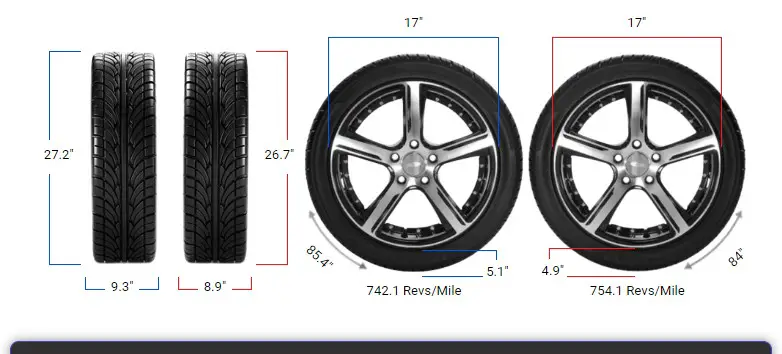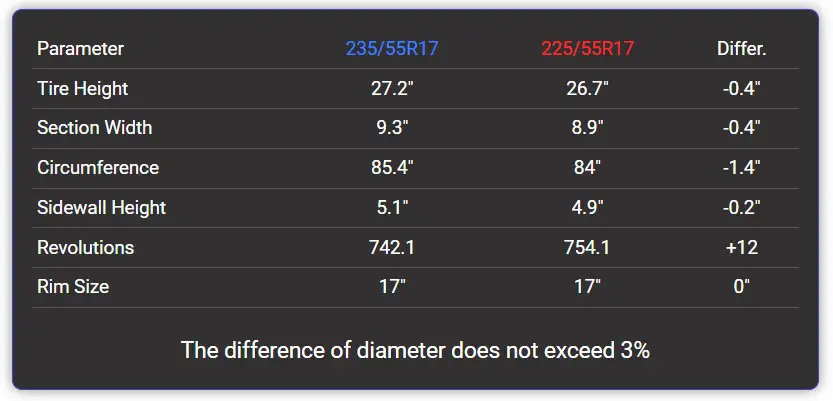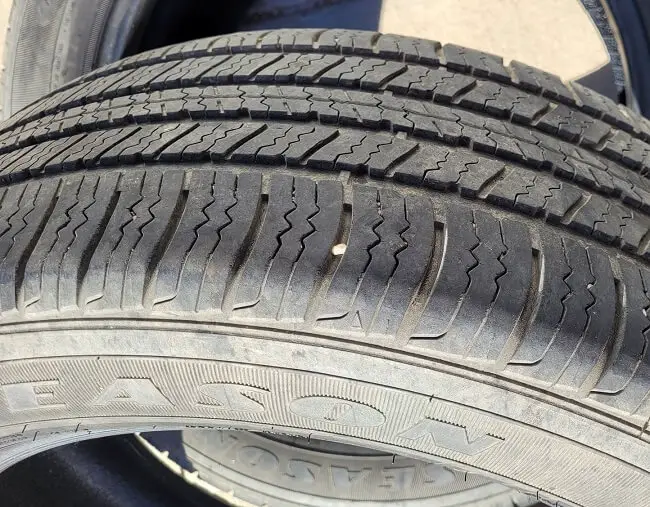Tire Size 235/55r17 vs 225/55r17

Tire size changes can significantly impact vehicle performance. Let’s explore the effects of switching from 235/55r17 to 225/55r17 tires, examining both benefits and potential drawbacks.
- The diameter difference is within the acceptable 3% range.
- Narrower tires may improve fuel efficiency slightly.
- Speedometer accuracy will be minimally affected.
- Slight changes in handling and traction can be expected.
- Overall vehicle appearance may be subtly altered.
235/55r17 vs 225/55r17 Table
The primary difference between 235/55r17 and 225/55r17 tires lies in their width. This change, while seemingly small, can have noticeable impacts on both on-road and off-road driving experiences.

Fitment Guide
It’s crucial to stay within the 3% diameter difference range. In this case, the diameter difference is -1.6%, well within the acceptable range.
This means the interchange is recommended, and no major adaptations are necessary to prevent issues like rubbing or clearance problems.
On-Road Impact
Switching to narrower tires can affect various aspects of on-road performance. Let’s examine how this change impacts everyday driving experiences.
- Handling: The narrower 225/55r17 tires may provide slightly less grip in dry conditions due to their reduced contact patch. However, this difference is minimal and might not be noticeable to most drivers. In wet conditions, the narrower tires could potentially perform better by reducing the risk of hydroplaning.
- Fuel Efficiency: One potential benefit of switching to narrower tires is improved fuel efficiency. The 225/55r17 tires have less rolling resistance due to their smaller contact patch, which can lead to marginal gains in gas mileage. However, this improvement is likely to be small, perhaps 1-2% at most.
- Ride Comfort: The change in tire width might result in a slightly different ride feel. The narrower tires may absorb road imperfections differently, potentially leading to a marginally smoother ride. However, this effect is likely to be subtle and may not be noticeable to many drivers.
- Speedometer Accuracy: The slight difference in tire diameter (-1.6%) will affect speedometer readings. At 20 mph, the actual speed will be 19.68 mph. This means the vehicle will be traveling slightly slower than the speedometer indicates, but the difference is minimal and unlikely to cause any significant issues.
- Aesthetics: The narrower tires may give the vehicle a slightly different look. Some drivers might prefer the appearance of the wider 235/55r17 tires, while others may appreciate the sleeker look of the 225/55r17 size. This is largely a matter of personal preference.

Off-Road Impact
For those who occasionally venture off the beaten path, the tire switch can have some effects on off-road performance. Here’s what to expect when taking your vehicle with 225/55r17 tires off-road.
- Traction: In off-road situations, the narrower 225/55r17 tires may provide slightly less traction in loose surfaces like sand or mud. The reduced width means less surface area to “float” on soft terrain. However, this effect is relatively minor and may only be noticeable in challenging off-road conditions.
- Ground Clearance: The change in tire size results in a very slight reduction in overall diameter (-0.43 inches). This translates to a minimal decrease in ground clearance, about 0.215 inches or 5.5mm. For most off-road situations, this small change is unlikely to have a significant impact on the vehicle’s ability to clear obstacles.
- Durability: The narrower tires may be slightly more susceptible to damage from sharp rocks or other off-road hazards due to their smaller profile. However, this difference is minimal, and tire durability is more dependent on the specific tire model and construction than the width difference between 235 and 225.
- Wheel Protection: The slightly narrower tires offer marginally less protection for the wheels against obstacles. This could potentially increase the risk of wheel damage in extreme off-road conditions, but for most casual off-road use, the difference is negligible.

What is the Difference Between 235/55r17 and 225/55r17?
The main difference between 235/55r17 and 225/55r17 tires lies in their width. The 235/55r17 tire is 10mm wider than the 225/55r17, which affects the tire’s contact patch with the road.
This width difference impacts various aspects of vehicle performance, including handling, traction, and fuel efficiency.
The wider 235/55r17 tire generally provides more grip in dry conditions but may have slightly higher rolling resistance, while the narrower 225/55r17 could offer better fuel economy and potentially improved performance in wet conditions.
Can I Use 235/55r17 Instead of 225/55r17?
Yes, you can use 235/55r17 tires instead of 225/55r17. The diameter difference between these two tire sizes is only -1.6%, which falls well within the recommended 3% tolerance.
This means the interchange is generally safe and won’t significantly affect your vehicle’s performance or require major modifications.
However, keep in mind that the wider tire may have slight impacts on handling, fuel efficiency, and speedometer accuracy.
How Much Taller Is A 235/55r17 Tire Than A 225/55r17?
A 235/55r17 tire is 0.43 inches (11 mm) taller than a 225/55r17 tire. The 235/55r17 has a diameter of 27.18 inches (690.3 mm), while the 225/55r17 has a diameter of 26.74 inches (679.3 mm).
This height difference is relatively small, representing a -1.6% change in overall diameter.
How Much Wider is a 235/55r17 Tire Than a 225/55r17?
A 235/55r17 tire is 0.39 inches (10 mm) wider than a 225/55r17 tire. The 235/55r17 has a width of 9.25 inches (235 mm), while the 225/55r17 has a width of 8.86 inches (225 mm).
This width difference represents a -4.3% change, which is more significant than the height difference and is the primary distinction between these two tire sizes.
Our Observation
Switching from 235/55r17 to 225/55r17 tires offers a mix of subtle benefits and drawbacks. The 225/55r17 tires may provide slight improvements in fuel efficiency and wet-weather performance on-road.
However, they may offer marginally less dry traction and off-road capability. The impact on both on-road and off-road performance is generally minimal, with most drivers unlikely to notice significant changes in everyday use.
The choice ultimately depends on individual priorities, whether it’s maximizing fuel efficiency, maintaining optimal off-road performance, or achieving a specific aesthetic look. For most drivers, the differences will be negligible, making either tire size a viable option.

Meet Caitlin McCormack, a Tire Size Expert and Blogger Passionate About Everything Related to Tires. With Years of Experience in the Tire Industry, Caitlin Has Become an Expert in Tire Sizes and Their Impact on Vehicle Performance.
